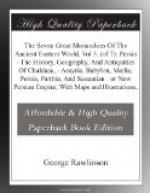Of all necessary minerals probably none was so plentiful and so widely diffused as salt. It was not only in Persia Proper that nature had bestowed this commodity with a lavish hand—there was scarcely a province of the Empire which did not possess it in superfluous abundance. Large tracts were covered by it in North Africa, in Media, in Carmania, and in Lower Babylonia. In Asia Minor, Armenia, Syria, Palestine, and other places, it could be obtained from lakes. In Kerman, and again in Palestine, it showed itself in the shape of large masses, not inappropriately termed “mountains.” Finally, in India it was the chief material of a long mountain-range, which is capable of supplying the whole world with salt for many ages.
Bitumen and naptha were also very widely diffused. At the eastern foot of the Caucasus, where it subsides into the Caspian Sea, at various points in the great Mesopotamian plain, in the Deshtistan or low country of Persia Proper, in the Bakh-tiyari mountains, and again in the distant Jordan valley, these two inseparable products are to be found, generally united with indications of volcanic action, present or recent. The bitumen is of excellent quality, and was largely employed by the ancients. The naphtha is of two kinds, black naphtha or petroleum, and white naphtha, which is much preferred to the other. The bitumen-pits also, in some places, yielded salt.
Another useful mineral with which the Persians were very plentifully supplied, was sulphur. Sulphur is found in Persia Proper, in Carmania, on the coast of Mekran, in Azerbijan, in the Elburz, on the Iranian plateau, in the vicinity of the Dead Sea, and in very large quantities near Mosul. Here it is quarried in great blocks, which are conveyed to considerable distances.




